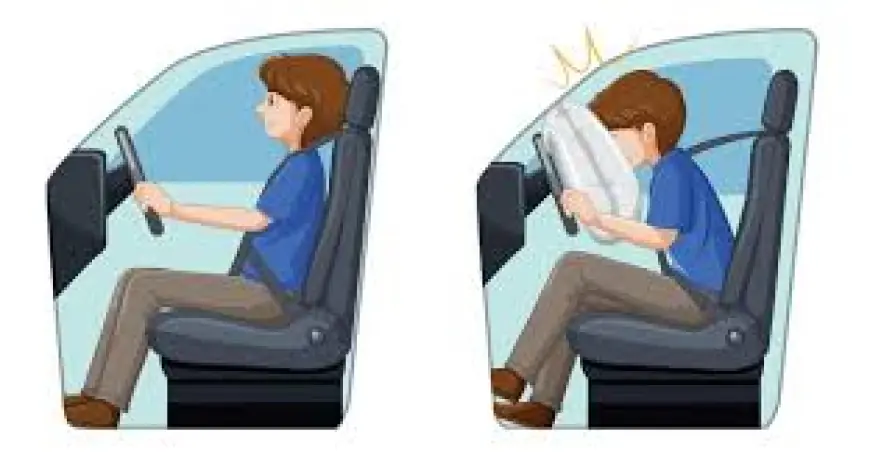Airbags and Seatbelts Market 2030
Key drivers of the Global Airbags and Seatbelts Market include stringent safety regulations imposed by governments worldwide.

The Global Airbags and Seatbelts Market stood at USD 38.16 Billion in 2023 and is projected to grow at a CAGR of 7.10% between 2025 and 2029. This growth underscores the rising importance of occupant safety as a cornerstone of the automotive industry. As vehicles become more advanced and consumer expectations shift toward smarter, safer, and more reliable mobility, airbags and seatbelts continue to serve as indispensable safety features.
These systems, once considered basic protective measures, have now evolved into sophisticated technologies integrated with advanced sensors, real-time monitoring, and smart deployment mechanisms. They not only enhance survival chances during collisions but also reduce the severity of injuries, reaffirming their critical role in modern vehicle design.
Emerging Trends in the Airbags and Seatbelts Market
1. Multi-Stage and Smart Airbag Deployment
One of the most significant innovations shaping the market is multi-stage deployment technology, where airbags adjust their inflation based on the severity of the collision. This prevents unnecessary force during minor crashes while offering maximum protection in severe accidents.
Additionally, smart airbags are being developed that use sensor data from vehicle systems, including passenger weight, seating position, and crash dynamics, to deploy in the most effective manner possible.
2. Integration of Sensors and IoT
Modern seatbelt and airbag systems now work hand-in-hand with IoT-enabled sensors. Occupant detection sensors, seat occupancy monitoring, and predictive algorithms are becoming common, paving the way for highly personalized safety mechanisms.
For example, adaptive seatbelts adjust tension automatically during emergencies, while pretensioners activate instantly upon collision detection, minimizing forward movement of the occupant.
3. Expansion of Side, Curtain, and Knee Airbags
Beyond the traditional front airbags, there is rising adoption of side-curtain airbags, rear-seat airbags, and knee airbags. This expansion ensures a 360-degree safety net for occupants, addressing diverse crash scenarios such as rollovers and side impacts.
4. Sustainability and Eco-Friendly Materials
Manufacturers are increasingly adopting recyclable fabrics and lightweight composites to develop airbags and belts. These eco-conscious materials reduce environmental impact while maintaining structural strength and safety.
5. Safety in Electric and Autonomous Vehicles
As EVs and autonomous vehicles gain market share, airbags and seatbelts are being redesigned to accommodate new seating layouts and crash dynamics. For example, airbags for rotating seats in autonomous cars are under active research.
Download Free Sample Report: https://www.techsciresearch.com/sample-report.aspx?cid=22603
Market Drivers
The growth trajectory of the airbags and seatbelts market is influenced by several powerful drivers:
1. Rising Road Safety Awareness
Consumers worldwide are becoming more conscious of vehicle safety ratings and actively prefer cars with advanced protective systems. This heightened awareness creates a pull factor for automakers to invest in state-of-the-art safety features.
2. Stringent Regulatory Frameworks
Governments in North America, Europe, and Asia-Pacific enforce mandatory airbag and seatbelt regulations. From requiring dual front airbags to mandating child-restraint systems, these regulations ensure widespread adoption across all passenger and commercial vehicles.
3. Growth in Passenger Car Sales
With passenger cars dominating global auto production, the demand for airbags and seatbelts naturally surges. Millions of new cars produced annually across Asia-Pacific, Europe, and Latin America are equipped with increasingly advanced safety systems.
4. Technological Innovations
Continuous R&D investment is yielding adaptive seatbelts, rear-seat protection, and AI-driven crash sensing systems. These innovations not only enhance safety but also serve as differentiators for automakers in a competitive marketplace.
5. Expansion of Emerging Markets
Rapid industrialization and increasing car ownership in countries like India, China, Brazil, and Indonesia have created vast opportunities for airbag and seatbelt manufacturers.
Industry Key Highlights
- Market Size 2023: USD 38.16 Billion
- CAGR (2025–2029): 7.10%
- Core Drivers: Road safety awareness, regulations, vehicle production boom
- Technological Shift: Smart sensors, adaptive seatbelts, multi-stage airbags
- Dominant Segment: Passenger cars
- Regional Leadership: Asia-Pacific leads due to high vehicle production
- Challenges: High R&D costs, integration complexities, reliability concerns
- Opportunities: EV safety systems, autonomous vehicle adaptations, sustainable designs
Passenger Cars: The Dominant Segment
Passenger cars hold the largest market share in the global airbags and seatbelts industry. Their dominance is attributed to:
- High Production Volumes: Millions of passenger vehicles are sold annually, far outpacing commercial vehicles.
- Stringent Safety Regulations: Passenger cars are often the first segment to comply with new airbag mandates.
- Consumer Preference: Buyers prioritize safety features when choosing new vehicles.
- Technological Adoption: Passenger cars frequently serve as testing grounds for new innovations such as curtain airbags and adaptive belts.
As a result, this segment continues to fuel the majority of industry revenues.
Competitive Analysis
The competitive landscape of the airbags and seatbelts market is shaped by leading automotive suppliers who invest heavily in R&D, partnerships, and global expansion.
Major Players:
- Hyundai Mobis Co. Ltd. – Strong presence in Asia-Pacific, known for innovation.
- Toyoda Gosei Co., Ltd. – Specializes in airbags and steering wheels.
- Robert Bosch GmbH – Integrates safety systems with electronics and sensors.
- Continental AG – Focuses on smart airbags and advanced restraint systems.
- ZF Friedrichshafen AG – Strong in pretensioners and adaptive seatbelt systems.
- Autoliv Inc. – Global leader in airbag and seatbelt manufacturing.
- Joyson Safety Systems – Known for collaborative innovations with automakers.
- Aptiv PLC – Specializes in system integration for intelligent safety features.
- Denso Corporation – Develops advanced sensing solutions for airbag deployment.
- Wenzhou Far Europe Automobile Safety System Co., Ltd. – Competitive pricing in emerging markets.
Competition is intensifying as players race to address the unique safety challenges of EVs and autonomous vehicles.
Future Outlook
The global airbags and seatbelts market is set for transformative growth between 2025 and 2029. Key expectations include:
- Integration with AI: Predictive crash response will enhance deployment accuracy.
- Customization for EVs: Special designs will protect occupants in battery-dense vehicle structures.
- Focus on Rear-Seat Safety: With more families and ride-sharing services, rear-seat airbags and belts will gain traction.
- Emergence of 4D Safety: Airbags may soon interact with external crash sensors, offering preemptive inflation before impact.
- Regional Expansion: Asia-Pacific will dominate production, while North America and Europe will lead in regulatory advancements.
Overall, the industry will evolve toward smarter, greener, and more adaptive solutions that prioritize holistic occupant protection.
10 Benefits of the Research Report
- Provides detailed insights into global market size and share.
- Highlights growth drivers, restraints, and opportunities.
- Covers regulatory frameworks shaping industry dynamics.
- Analyzes passenger car dominance in safety adoption.
- Examines technological innovations like adaptive seatbelts.
- Offers competitive analysis of key global players.
- Identifies high-growth regions and emerging markets.
- Forecasts future trends and market trajectories to 2029.
- Provides actionable intelligence for investment strategies.
- Helps automakers and suppliers align with evolving safety demands.
Conclusion
The Global Airbags and Seatbelts Market is no longer about just meeting regulatory requirements—it is about redefining occupant safety in an era of smarter mobility. Passenger cars dominate the market, but the future lies in innovations designed for EVs, autonomous vehicles, and sustainable solutions.
Manufacturers that successfully balance cost-effectiveness, innovation, and regulatory compliance will thrive in this rapidly growing market. As consumer expectations align with technological possibilities, airbags and seatbelts will remain the cornerstone of vehicle safety systems, ensuring protection, trust, and confidence for billions of road users worldwide.
Contact Us-
Mr. Ken Mathews
708 Third Avenue,
Manhattan, NY,
New York – 10017
Tel: +1-646-360-1656
Email: [email protected]
Website: www.techsciresearch.com
What's Your Reaction?
 Like
0
Like
0
 Dislike
0
Dislike
0
 Love
0
Love
0
 Funny
0
Funny
0
 Angry
0
Angry
0
 Sad
0
Sad
0
 Wow
0
Wow
0


















































